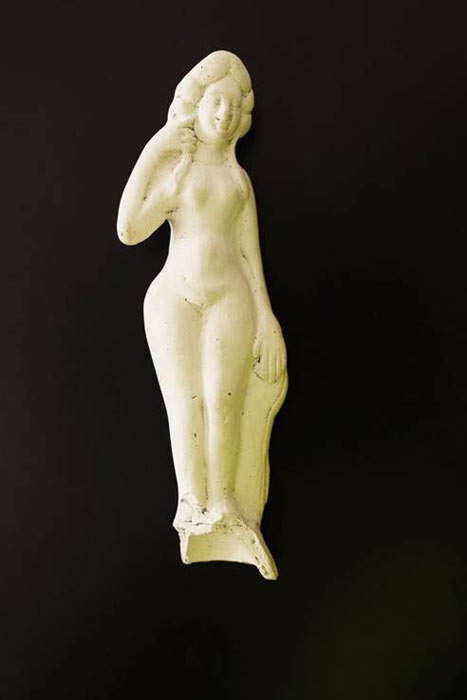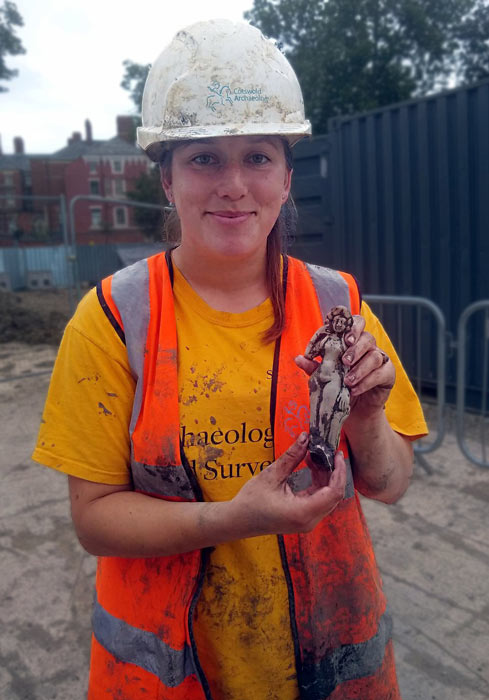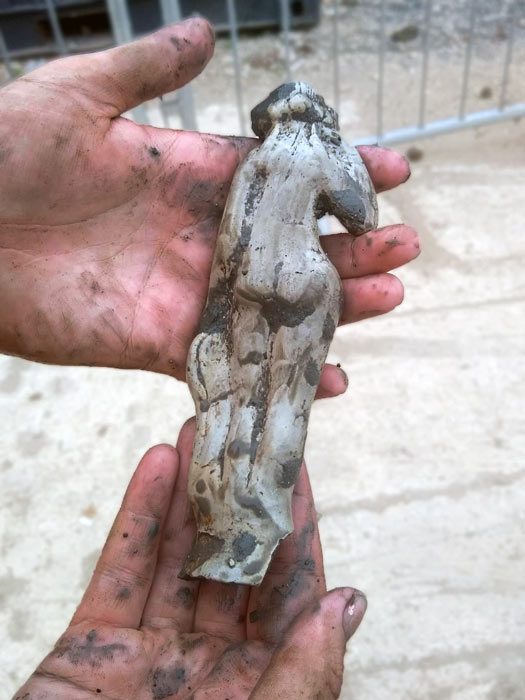A 17-centimeter (6.7 inch) tall Roman Venus figurine has been discovered by archaeologists in the city of Gloucester, England. This 1,800-year-old find has created considerable excitement in the archaeological community. Anthony Beechey of Cotswold Archaeology was quoted by BBC News as saying, “This has been the most exciting find of my career in archaeology so far. The figurine provides a really important, tangible link between the people of Gloucester and their past.”

The cleaned Roman Venus figurine found in Gloucester, England. ( GloucestershireLive)
The Amazing Gloucester Roman Venus Figurine Find
The statuette was discovered beneath the site of a new social and digital center, fittingly called the ‘Forum,’ being developed by the Gloucester City Council.
The figurine is believed to be that of Venus, the Roman goddess of love, beauty, victory, fertility and prostitution. Venus is the Roman counterpart of the Greek goddess Aphrodite . The Roman Venus figurine is thought to be 1800 years old and clearly reveals another part of Britain’s Roman past.
Julius Caesar , who claimed descent from Venus, invaded Britain twice, in 54 and 55 BC. Beginning in AD 43, Romans conquered large parts of Britain.
Gloucester itself, which is located 90 miles (145 kilometers) west of London, had its beginnings in AD 48 as a Roman fort called Glevum. The Cotswold Archaeology team digging at the site also found foundations of buildings that may have belonged to a suburb outside the walls of the Roman fort .
Just last year archaeologists digging beneath a demolished multi-level car park in Gloucester also discovered the remains of the Whitefriars Carmelite friary , which played an important function in the city between the 13th and 16th centuries. This was a very valuable find because the location of the Whitefriars friary had long been debated, but its ruins had not been found. Archaeologists have so far found wall foundations, floor tiles, and a stone coffin containing two burials.

The Roman Venus figurine just after it was found in the hands of a Cotswold Archaeology team member. ( Cotswold Archaeology )
The Venus of Gloucester: Likely A Home Deity
The figure found in Gloucester dates to the first century AD and is intact except for the base. It is made of pipeclay, a white clay found along the Rhine and Meuse rivers in modern-day Germany. One hand of the pale-grey and creamy-white, tiny-waisted figure rests along her thigh while the other is stroking her long hair. Archaeologists believe she was a religious deity enshrined in someone’s home.
Andrew Armstrong, city archaeologist at Gloucester City Council, observed that the figurine was in very good condition and represented a valuable find for Gloucester. He is reported by Smithsonian Magazine to have added, “We know pieces like these were made in central France and the Rhineland/Mosel region of Germany during the first and second centuries. It seems certain the figurine is from this period and is a representation of Venus. She would most likely have stood in someone’s home shrine for the goddess.”
He added that the figurine was found while digging a new route for a culvert to the River Twyver in what must have been a Roman rubbish dump . He explained that it had been expertly cleaned by specialists, as water would have dissolved the white clay material the figurine was made of.

The back side of the Roman Venus figurine found in Gloucester, England. ( Cotswold Archaeology )
Such figurines are associated with fertility, sexuality, beauty, and motherhood. Similar figurines have been found in Britain that predate the Romans. Meaning that the ancient Britons later conflated their fertility goddesses with the Roman Venus goddess who had similar attributes.
Unlike the Gloucester Venus figurine, with its distinctive delicate face and hair and well-formed hands, most of the earlier English fertility statues were faceless and had exaggerated breasts and hips. The oldest Venus of this type is the Venus of Hohle Fels, which is believed to be around 40,000 years old. She was found in a German cave and made out of the tusk of a mammoth.
Archaeologists are very excited about the rich finds they are discovering beneath the redevelopment project in Gloucester, particularly the work preceding the building of the Forum.
Talking to Gloucester Live , Marino Cardelli, Project Officer at Cotswold Archaeology and lead archaeologist at the site said, “The Forum site features treasures of inestimable historical value, buried structures and artefacts; a testimony of the city’s history and culture.”





